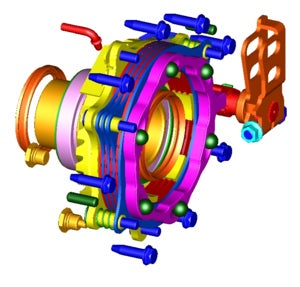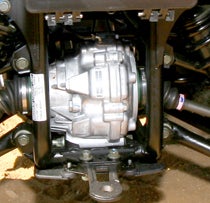|
The new Yamaha Big Bear 400 has many user-friendly features that will make this workhorse a fun and reliable ride for everyone who owns one. This Big Bear 400 was built for a market that is known for getting in some seriously muddy and wet conditions. There are many intriguing facts about the Big Bear but none so interesting as the Rear braking system. As we all know brakes on an ATV are defiantly something that cannot be ignored. If standard brakes are left without maintenance for even short periods of time it will lead to costly repairs and not to mention it endangers the rider and anyone around the ATV if it gets out of control. The main reason ATV braking systems fail is maintenance or the lack thereof.
With the New Yamaha Big Bear 400 being built specifically for the deep rutted creek bottoms and mud puddles that turn into quick sand, the engineers over at Yamaha decided to configure a system that was maintenance free 99% of the time. This rear braking system is totally enclosed in its sealed casing along with the rear gearing and pinion shaft. The axles are fed out of the unit and firm seals are in place to hold out water and debris. The idea behind all of this is that if nothing can get in then there will not be any possibility of the parts inside being damaged prematurely.
So lets start with the engineer’s thinking behind Yamaha’s new Big Bear 400 rear brakes.
 |
For years brake parts manufacturers have been selling brake pads off the shelves as fast as they could make them. Well that’s good for them but it can be a nightmare of choices for the owners of the ATV’s that need those parts not to mention they are expensive. While riding in mud and deep water there is always the possibility that sand, silt and even mud will come in contact with the parts of the ordinary brake system. This cause’s wear and just a few long days in these conditions will ruin all parts that are subjected to these elements. That’s where Yamaha decided to try and build an ATV that could keep going and going and going without the need of maintenance. Another point behind this new feature is that if you are riding with your friends and you cross a stream or encounter water and mud the possibility of your brakes even working is remote. Once the water or mud comes in contact with the brake pads it makes them fairly slick and when you go for the security of your front or rear brakes they are weak and slow to respond if they do at all. I don’t know about you but running into the back of my friends ATV isn’t well received not to mention it will hurt at some point.
 |
With the idea of a modern clutch system in their heads the opposite would essentially be a good starting point correct? If pulling in the clutch is designed to release drag or friction on the plates to allow us to change gears by disengaging the transmission then all they had to do was reverse this theory. That’s how it works in a nutshell. The five plates that are inside this enclosure are being separated by only a small amount. The brake lever is pulled in and the plates are engaged one to another and there you have friction, which brings the Big Bear 400 to a stop. The design is meant to put braking pressure onto the actual axle itself and if viewed from the rear of the Big Bear 400 the braking plates are located on the right side of the housing.
The next great thought that came from the engineers was to allow the braking plates to be bathed or rest in the 80-weight gear oil that is used in the rear gearing housing. This would assist in keeping the plates cool during hard breaking and help keep brake fade to a minimum. When it comes to maintenance on this system Yamaha has estimated the brakes on the rear of the Big Bear 400 to out last the life of the ATV. Although the Big Bear gear oil could be changed at reasonable intervals to protect the gears and the braking plates.
To know that you will always have some form of stopping capacity makes the ride a little more enjoyable. This in itself is a great selling point. Safety and reliability are the keys to Yamaha’s mission while developing the next generation of ATV’s.
RS |